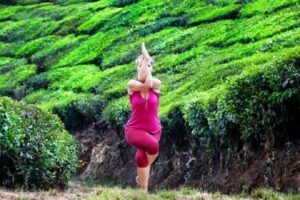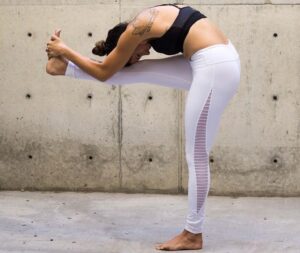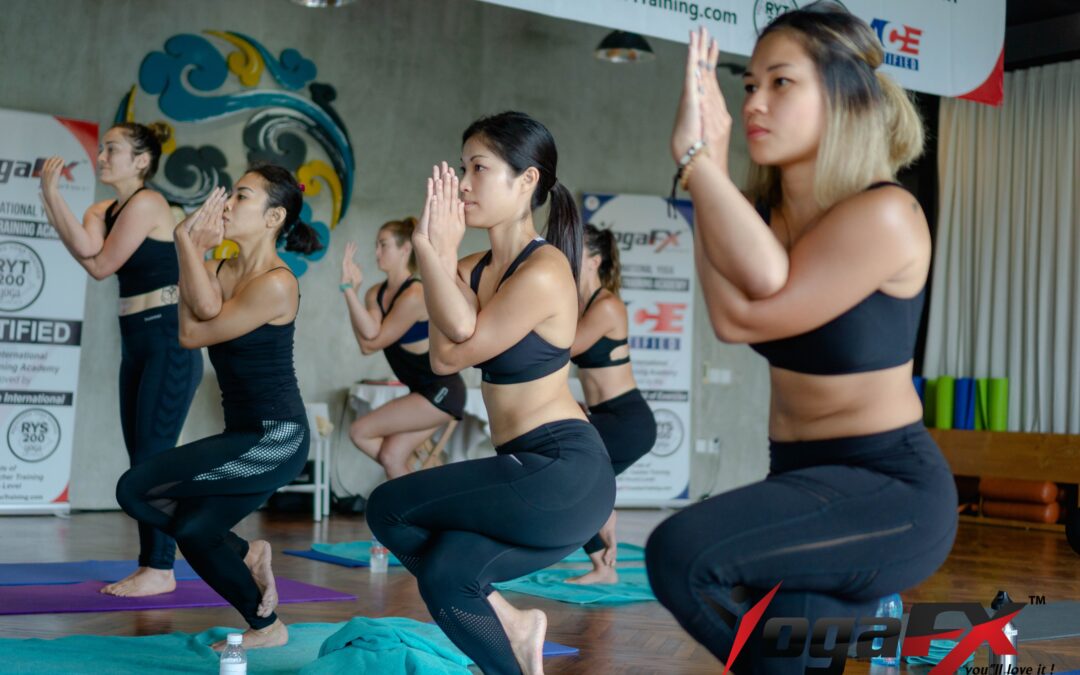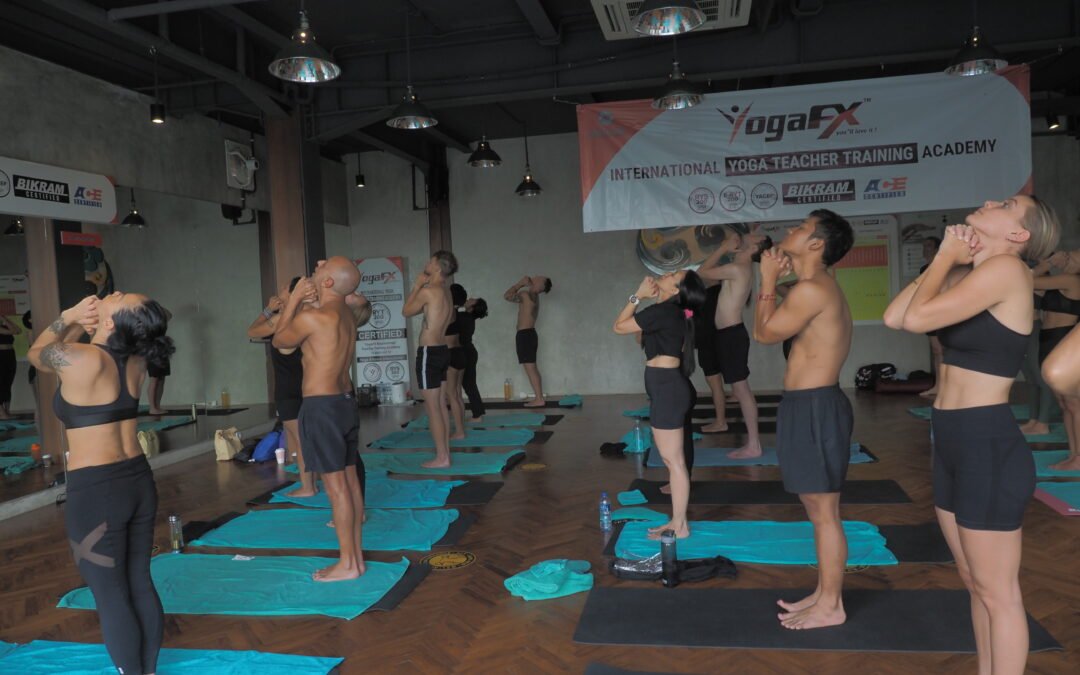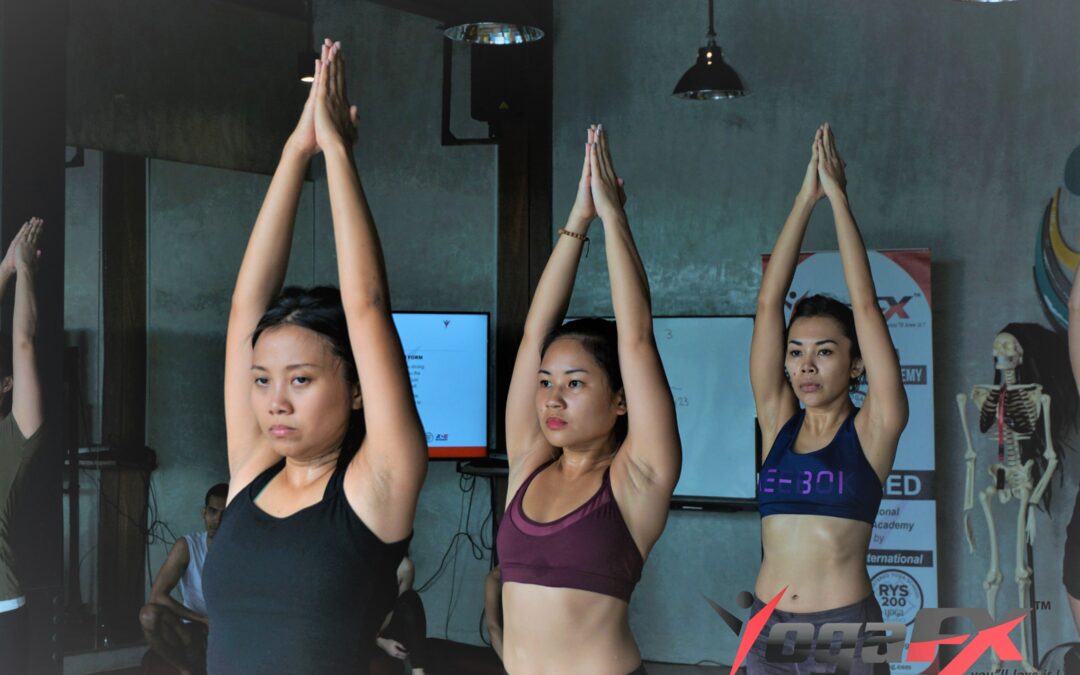One of the most popular styles of yoga in the world. Founded by Bikram Choudhury in the 1970s, Bikram yoga consists of 26 poses yoga asanas, and two pranayama exercises that never change.
People who practice Bikram yoga practice these postures and pranayamas in order to stretch and strengthen their bodies and the heated room helps to go deeper into the posture and sweat out toxins. Specifically, Bikram Yoga is often referred to as the 26+2 which makes up the 26 same poses and 2 breathing exercises. In addition, Most poses are performed twice and they’re typically held between 6-60 seconds depending on the pose. Below, you’ll find the 26 poses of Bikram yoga, so you can try it out for yourself at home!
Utkatasana (Awkward Pose)
 Purposes and Benefits:
Purposes and Benefits:
1. Continues warming up body for all other yoga poses
2. Heals chronically cold feet
3. Circulates fresh blood to knees and ankles
4. Alleviates rheumatism and arthritis in legs
5. Strengthens and firms all muscles of legs and upper arms
6. Increases hip flexibility and relieves muscular aches and cramps, also
7. Helps to cure slipped discs and other lower-spine problems
Garurasana (Eagle Pose)
 Purposes and Benefits:
Purposes and Benefits:
1. Works into 12 major joints of body
2. Warms body and readies it for next 3 poses
3. Promotes health of central nervous system
4. Enhances lymphatic functions
5. Improves balance, hip-joint mobility, and immune system
6. Strengthens deltoid, trapezius, and legs, also
7. Reduces varicose veins
Dandayamana-Janushirasana (Standing Head to Knee Pose)
 Purposes and Benefits:
Purposes and Benefits:
1. Uses all major muscle groups
2. Exercises digestive and reproductive organs
3. Improves concentration and mental strength
4. Unifies body and mind
5. Tightens abdominal and thigh muscles
6. Lessens/mitigates diabetic disorders
7. Squeezes and flushes out ovaries, uterus, and internal abdominal organs, such as gall bladder, pancreas, and spleen
8. Increases flexibility of sciatic nerves, also
9. Strengthens the following: Tendons, hamstrings, and biceps of thigh muscles; Biceps, triceps, deltoids, trapezius, back muscles, latissimus dorsi, and scapula.
Just make sure to work into the pose slowly. It’s not a race, and the last thing you want is an injury.
Trikanasana (Triangle Pose)
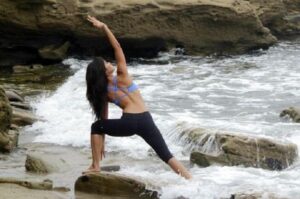
Opens and increases the flexibility of hip joints, Good for kidneys, thyroid, and adrenal glands, Works for all muscular groups simultaneously. Trikonasana or Triangle Pose is practiced next in the Bikram series to revitalize, strengthen, and stretch the body and mind. Of focus in this pose would be the hips, legs, and core. This version of the Triangle pose practiced in Bikram yoga is very different from the norm in other styles. Also Specifically, this pose would be called Extended Side Angle in other various yoga classes, it’s a great stretch for your side body.
Ardha-Kurmasana (Half Tortoise Pose)
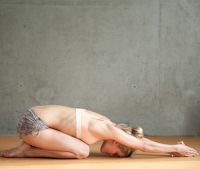
Improves mobility of shoulder girdle and associated muscles (scapula, deltoids, triceps, latissimus dorsi), Stretches lower part of the lungs, increases lung capacity, also Relieves stress and migraines. Provides maximum relaxation, Helps indigestion, and stretches the lower part of the lungs, increasing blood circulation to the brain. Firms the abdomen and thighs, Increases the flexibility of hip joints, scapula, deltoids, triceps, and latisimus dorsi muscles. Provides maximum relaxation, Cures indigestion, constipation, flatulence. Also, good for emphysema and asthma. Increases blood flow to the brain bringing mental clarity, good memory.
Bhujangasana (Cobra Pose)
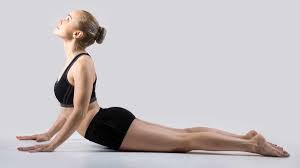
Improves flexibility and tone of spinal muscles, massages, works, and tones back muscles, also helps relieve and prevent lower backache, Rejuvenates spinal nerves enriching them with a rich blood supply. Increases in spinal strength and flexibility help prevent lower back pain and help cure lumbago, rheumatism, and arthritis of the spine.
Improves menstrual problems (irregularity, cramps, backache). Cures loss of appetite. It Helps Improve posture and the functioning of the liver and spleen. Strengthens the deltoids, trapezius, and triceps. Increases spinal strength and flexibility. Also, Helps prevent lower backache, cure lumbago, rheumatism, and arthritis of the spine. Improves the functioning of the liver and spleen.
Dhanurasana (Bow Pose)
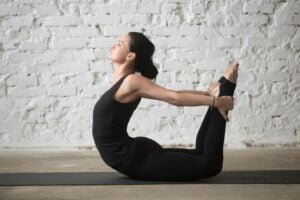
Improves strength and balance Reduces abdominal fat and strengthens abdominal muscles, Opens diaphragm and expands the chest region, improves respiratory conditions, Develops internal balance and harmony. Improves the functioning of the large and small intestines, the liver, kidneys, and spleen. Help straighten rounded spines, relieves backaches, and improves kyphotic upper body posture (rounded shoulders) opening the rib cage and strengthening the upper back, also permitting maximum expansion of the lungs and increased oxygen intake. Revitalizes all spinal nerves by increasing the circulation of the spine.
Improves digestion and strengthens abdominal muscles, upper arms, thighs, and hips. Works entire spine. Also, Helps with back pain and scoliosis. Holds vertebrae in position.
Here is another Bikram yoga poses from 26 poses :
Tadasana (Tree Pose), Dandayamana-Bibhaktapada-Paschimotthanasana (Standing Separate Leg Stretching Pose), Savasana (Dead Body Pose), Sit-up, Poorna-Salabhasana (Full Locust Pose), Supta-Vajrasana (Fixed Firm Pose), Ustrasana (Camel Pose), Sasangasana (Rabbit Pose), Janushirasana with Paschimotthanasana (Head to Knee Pose with Stretching Pose), Ardha-Matsyendrasana (Spine Twisting Pose), in Vajrasana (Blowing in Firm Pose), Pranayama Series (Standing Deep Breathing), Padangustasana (Toes Stand Pose), Dandayamana-Dhanurasana (Standing Bow Pulling Pose), Salabhasana (Locust Pose), Ardha-Chandrasana with Pada Hastasana (Half Moon Pose with Hands to Feet Pose), Tuladandasana (Balancing Stick Pose), Dandayamana-Bibhaktapada-Janushirasana (Standing Separate Leg Head to Knee Pose), also Pavanamuktasana (Wind Removing Pose),




